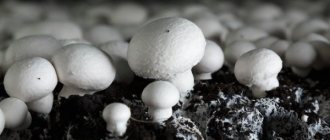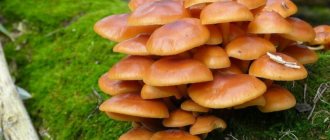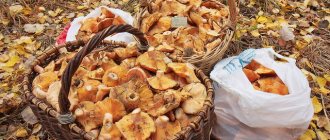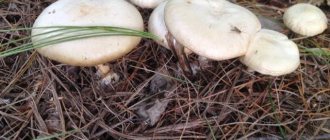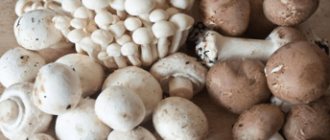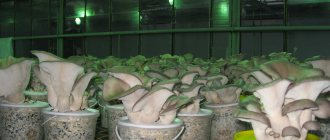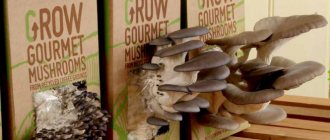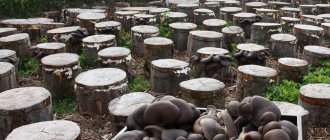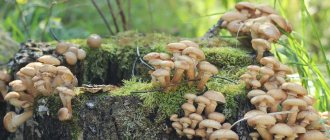If they tell you that growing oyster mushrooms is easy for beginners, don’t believe it. Knowing the theory is not enough. Practical experience is valuable. Many factors influence success, everything needs to be taken into account. This guide goes into detail about growing oyster mushrooms from scratch.
Before mastering mushroom growing, you need to understand the process from the inside and learn the technology for growing oyster mushrooms at home. The end result should be a commercial oyster mushroom mini-plantation ready for cutting. It is worth carefully studying how to properly grow mushrooms of this type indoors, as well as on stumps in the garden.
Oyster mushrooms: beneficial properties
Oyster mushrooms are valued for their nutritional and beneficial properties. These mushrooms are 70 percent protein, which is why they are sometimes called “mushroom meat.”
Oyster mushrooms contain fiber (chitin), which is useful for normalizing microflora, improving the functioning of the gastrointestinal tract and facilitating the process of removing digestive products and toxins.
The presence of sugar and sugar alcohols gives oyster mushroom dishes a special taste, and the ability to break down fats allows mushrooms to be included in dietary foods.
Necessary equipment
Oyster mushrooms can be grown on stumps, in bags or on racks. There are several types of cultivation racks. Most of them are designed to accommodate the maximum number of mushroom blocks at minimal cost.
The most common method of cultivation is the method of hanging bags of substrate on large pointed pins. This way the block is securely fixed, but, if necessary, it can be easily rotated (Figure 7).
Note: If the racks are located in an unheated greenhouse, mushrooms can only be grown in them in spring or autumn. In addition, the structure is shaded from the outside using reed covering.
Depending on the type of substrate used, adherence to technology and maintenance of the microclimate, the full cultivation cycle is 8-10 weeks (the period from the introduction of mycelium to harvesting and removal of old blocks). If the cycle is longer, not only the financial benefits are reduced, but the risk of developing diseases also increases.
Mushrooms ripen in waves, and the bulk of the harvest occurs in the first and second fruitings, therefore, in large mushroom farms, after the second wave of harvest is harvested, the mushroom blocks are completely replaced and the cycle is repeated. Useful practical recommendations for forming mushroom blocks are given in the video.
Methods of growing oyster mushrooms: extensive and intensive
Oyster mushrooms at home can be grown naturally in open ground (extensive method) and in a room specially equipped for this (intensive method).
To grow a small amount of mushrooms, a simple and affordable method of growing them in open ground in a garden or summer cottage is suitable. The extensive method does not require special equipment, significant financial costs and time.
- Oyster mushrooms can be grown on stumps or wooden blocks. You will also need mycelium, which you can buy or make yourself.
- The area of land for cultivation should be protected from direct sunlight. Planting should begin in the spring, when the threat of frost is minimal.
- The stumps on which mushrooms will grow must be moist. To do this, you should soak them for several days.
- In the stumps prepared in this way, you need to drill a hole about 8 cm deep, fill it with mycelium and cover it with clay.
- The stumps should be kept in a warm room, making sure to maintain moisture until the mycelium germinates. It looks as if the stumps are covered with white fluff.
- Now you need to dig small holes about 15 cm deep on a piece of land and “plant” hemp in them, then cover them with last year’s leaves and sawdust.
When grown extensively, mushrooms grow more slowly; harvest time is August-October. Under natural conditions, oyster mushrooms grow more slowly and are harvested from August to October.
Growing oyster mushrooms in an intensive way allows you to get the harvest much faster and without seasonal restrictions. You need to start with choosing a room and preparing equipment to create the desired microclimate. The room can be equipped in a basement, cellar or in a free outbuilding.
Substrate preparation is the basis for a good harvest
Oyster mushrooms are unpretentious, but it is important to prepare a high-quality nutrient medium to get more yield.
Various combinations of substrate are suitable for growing oyster mushrooms, but the most fertile options are considered to be:
- dried straw from wheat or barley;
- dry sawdust from deciduous trees;
- corn stalks or cobs;
- husks of sunflower or buckwheat seeds.
The main requirement for a nutrient substrate for oyster mushrooms is its freshness and the absence of mold or mildew of any kind.
Before planting mushroom mycelium, the base must be subjected to additional processing, which includes several stages depending on the selected type of soil and method of storing mushrooms:
- Hydrothermal treatment. Soaking dry base in hot water.
- Pasteurization. Blowing hot steam onto a pre-moistened substrate.
- Xerothermia. Similar blowing only in dry form.
When carrying out hydroprocessing, when the substrate is poured with hot water and allowed to brew for 2-3 hours or boiled for 25-30 minutes, then squeezed out, it is important to ensure that the composition is not too wet. To do this, bags with the treated composition are hung in a dry place and left for several days.
During this time, excess moisture will drain, after which, to increase fertility, the soil is divided into smaller fractions and mixed. After the necessary procedures, the material for planting should be moderately loose and slightly moistened. If you squeeze it with your hand, it should spring back, and water should not appear on the surface.
Detailed technology for growing oyster mushrooms
What you will need to do:
- Select and prepare the premises;
- Install equipment;
- Get substrate;
- Buy ready-made mycelium;
- Create the desired microclimate;
- Sowing;
- Caring for oyster mushrooms;
- Harvest.
The technology for growing oyster mushrooms intensively is quite simple. The main criterion by which you need to choose a room is the ability to create the necessary microclimate in it. And then it will be possible to grow oyster mushrooms in an apartment or on a balcony, in a basement or cellar, in a greenhouse or barn.
The conditions necessary to create and maintain the correct microclimate are as follows:
- Constant ventilation of the room;
- High humidity;
- Correct lighting;
- Certain temperature.
There should be constant air circulation in the room. If it is difficult to create natural ventilation for some reason, you need to install a fan.
Humidity should be maintained at 80-90 percent. To do this, you need to spray the mycelium daily or install an automatic humidity regulator.
The lighting should not be too bright.
- The optimal temperature range is between 10-25 degrees. To comply with it, you need to install a heating source.
- Be sure to sanitize the room. To prevent mycelium from becoming infected and mold from appearing, you need to treat the room with a special compound that can be bought at hardware stores. You also need to carry out disinfection, then rodents and pests will not appear. Cover the ventilation hole with an insect net.
- To place myceliums, prepare racks, boxes or hanging mounts.
Sowing of mycelium is carried out in a separate room. If this is not possible, a place for sowing is fenced off in the main room.
Substrate preparation
The substrate can be bought in special stores or made at home. It can be prepared from barley or wheat straw, sunflower husks, buckwheat husks, and husked corn cobs.
- Raw materials should not be rotten or moldy. It needs to be crushed, the particle size after that should not be more than 5-10 cm.
- The substrate must be treated with hot steam or boiled well (this will help get rid of insects and avoid infection). This is done with hot steam or boiling.
- You need to boil the substrate for about 2 hours, then strain and dry a little.
- The humidity of the finished raw material should be approximately 70 percent, the temperature 20-24 degrees.
- You can add fresh yeast to the prepared substrate immediately before planting. Yeast is added at the rate of 50g per 15 kg of substrate.
Equipment for the production of oyster mushrooms
In addition to ventilation devices for growing oyster mushrooms, other equipment will be required. In particular, gas or electric heaters are installed to heat the room, and LED or incandescent lamps are installed to extend daylight hours.
It is also necessary to provide racks or mounts on which the mushroom blocks will be located. It is advisable to immediately divide the room into several zones so that areas for preparing the substrate, sowing mycelium and growing fruiting bodies are located separately.
Mushroom growing chamber
The most modern method of growing mushrooms is the method using a special chamber. Such chambers are manufactured at industrial enterprises and are immediately equipped with all the necessary equipment for cultivating oyster mushrooms, champignons and other mushrooms.
Mycelium. Where to buy, how to grow it yourself
You can buy mycelium in special stores or contact an organization that grows mushrooms.
- When purchasing mycelium for the first time, it is worth taking a small amount for testing.
- A good mycelium should be yellow or orange in color, without the smell of ammonia and without dark spots (these are signs of mold).
- The mycelium is stored at a temperature of +2 degrees, and during transportation the temperature should not exceed 20 degrees.
If the storage rules are followed, the shelf life of the mycelium is 6-9 months
Methods for storing mycelium
Ways to store oyster mushrooms at home:
- in the cold;
- in liquid nitrogen.
For the first method, the mushrooms are moved to the refrigerator. Afterwards, the mushrooms are taken out, shaken and left to sit for several days. If the mycelium turns brown, it is spoiled and is not suitable for further use.
If you place the mycelium in liquid nitrogen, the structure will be preserved and the yield will remain high. Before storage, it is left at a temperature of +5°C for several days. If you frequently change the state of the mycelium (thawing and freezing), this has a bad effect on the quality of the material.
How to grow oyster mushroom mycelium yourself
The basis can be grain or wood. Raw materials, instruments and premises must be sterile.
- The first thing you need to get is the royal mycelium. It is taken from a fresh, healthy mushroom.
- Several pieces are taken out from the area near the cap with tweezers and treated with hydrogen peroxide.
- Place them in a container with ground grain, close tightly and store in a dark place for 14 days.
- A constant temperature of 20-22 degrees and average humidity are maintained. When the mycelium germinates, a white fluff appears on the planting material.
Next, you need to take grains of oats or wheat, boil for 30 minutes, strain and cool. Then fill the bags with grains halfway and sterilize. Add some royal mycelium there and close.
The intermediate mycelium germinates in about 3 weeks. The product should be stored in the refrigerator at a temperature of +2 degrees.
Landing
The mycelium should be removed from the refrigerator and kept for one day at room temperature. Next, you need to carefully knead the mycelium in a closed bag and leave it in the room for growing mushrooms for a day for acclimatization.
Then it must be carefully crushed by hand directly in a closed bag and transferred to the room in which the mushrooms will be grown, leaving for a day to acclimatize.
Planting should be done with a mask and gloves to avoid fungal spores getting into the lungs and to prevent infection of the mycelium by microbes. It is good to use a quartz lamp.
- Growing oyster mushrooms in bags: disinfect the bags, add 5 cm of substrate, apply mycelium along the edges of the bag with a layer of half a centimeter.
- Alternate layers until the bags are completely filled, adding the substrate as the last layer.
- The volume of bags must be at least 5 kg. The filled bags are tied and 2 cm cuts are made.
- Ventilation and germination of oyster mushrooms will occur through them.
- Place the cuts in a checkerboard pattern at a distance of about 10 cm. You can add mycelium through the cuts.
- Bags are placed on racks, in boxes or suspended from ceiling mounts.
Correct climatic conditions
The optimal temperature for crop growth is 18-24 degrees. At lower temperatures, growth slows down, and when it rises to 30 degrees, the mycelium dies. Humidity should be kept at 70 percent. Mycelium germination occurs faster in the dark.
When mushrooms appear, climatic conditions need to be changed. Increase humidity to 90 percent and lower air temperature to 10-12 degrees. The temperature should be lowered gradually, without sudden changes.
Caring for oyster mushrooms
The first mushroom shoots appear 12 days after sowing. Now it is necessary to illuminate the room for 8-10 hours every day. The light should be dim and diffused.
- Spray the bags regularly with water to maintain high humidity. The room needs to be ventilated.
- Mushrooms grow for 2 weeks. The bags are sprayed with water to maintain high humidity.
- Crops are inspected for diseases.
If the mushrooms have thin and long legs, it means the room is not ventilated enough; if they are weak and small, it means there is too much light. The substrate contaminated with mold is completely removed.
Harvesting
As soon as the mushroom caps lighten and the edges are aligned, you can begin harvesting.
- The size of the caps should not exceed 30 cm, height - 10 cm. Overgrown oyster mushrooms become tasteless and tough.
- Oyster mushrooms grow in clumps; you need to cut off the entire clump, otherwise the remaining mushrooms will interfere with the growth of the next harvest.
- The first harvest is usually the largest. Further, the growth of mushrooms begins to occur faster, a new harvest can be obtained after 8 days, but its volume decreases.
The harvest is stored in the refrigerator for no more than 72 hours (three days).
Cultivation of oyster mushrooms and the first harvest - how to care for mushrooms?
As soon as the incubation process is completed, the blocks with mycelium are transferred to a cooler room with an optimal temperature of 12-15 degrees. During cultivation, mushrooms need additional light. It is enough to install LED lamps with a power of 50-60 watts around the perimeter at the rate of 5-7 V per 1 sq. meter of area. The growth of oyster mushrooms in the basement is also well influenced by infrared lighting, but this method is more expensive from a financial point of view.
Periodic irrigation is also carried out with ordinary water at room temperature using sprayers, but not watering, since excess moisture in the bags will quickly provoke the appearance of fungal infections or mold on newly formed shoots.
In contrast to the incubation stage, during cultivation, ventilation must be constant and comprehensive: the more air circulates, the better the young mushrooms will feel. To prevent harmful flies from appearing, the mesh on the ventilation outlets and openings should be with a mesh of no more than 1 mm.
Oyster mushrooms are characterized by a high frequency of fruiting. If the required conditions are met, the first harvest can be expected within 30-35 days after the start of the second stage of cultivation. From one standard bag (5 kg), if high-quality vegetative material was used, you can get up to 3-3.5 kilograms of fresh mushrooms. Therefore, breeding this species can be considered as a promising business that can generate income.
The first wave is removed carefully, without tearing off the mushrooms, but cutting them off with a sharp knife under the stem, but you cannot remove all the fruits without exception; the smallest ones are left to prevent premature drying of the mycelium.
Next, the stem is removed, and the substrate is sorted and inspected for moldiness. If flies or ticks have multiplied, the traces of which are indicated by dark dimples similar to mini-bites, the entire block is removed and burned, it cannot be used in the future, the room is washed and additionally disinfected.
After harvesting the second and third waves of the crop, bags with substrate must be disposed of, as they are not suitable for re-growing. It will be possible to grow a new batch in the same place only 2-3 weeks after carrying out the necessary preventive and technical procedures.
Photo of growing oyster mushrooms
How to prepare the substrate
I put the straw in a forty-liter can, fill it with water and boil for five to ten minutes. Then I let it cool, put it in a plastic bag with holes and hang it so that excess moisture drains out of the straw. The straw should remain damp, but water should not drip from it.
Steaming the substrate significantly accelerates the overgrowth of the block with mycelium. If the substrate is not steamed, before the mycelium of the cultivated fungus masters it, pathogenic fungi unsuitable for food will grow in the substrate.
Oyster mushrooms in bags - where to start?
This method is one of the most common and convenient. You don't need special equipment or a lot of money. All that is needed is a special room, bags, substrate and mycelium.
Room
Choosing a place to grow mushrooms is one of the key points. A barn, garage or cellar is suitable as a room.
Ideally, you will need two rooms. In one, incubation will take place, and in the second, mushrooms will be grown directly.
Remember, the room must be disinfected before starting work. Whiten the walls with a solution of copper sulfate. Be sure to cover the ventilation holes with mesh so that midges cannot enter the room.
The key to success is favorable conditions inside. Moreover, at each stage they are different. The temperature level during incubation is 25 degrees, humidity is 70%. After incubation, keep the temperature to 18 degrees and humidity from 80% to 95%.
Harvesting
The appearance of the mushrooms indicates that the harvest is ripe. They become large - the width of the cap is approximately 13 cm, and the height of the mushroom is 10 cm. It is important to prevent the mushroom from overgrowing. Overripe, it becomes tasteless and tough.
Oyster mushrooms grow in clusters. The entire splice should be cut off. Mushrooms left behind will interfere with the growth of others. To do this, use a sharp knife with a thin blade.
Note that the first wave of the harvest is the most fruitful. Subsequently, the mushrooms grow faster, but in smaller quantities.
conclusions
- Growing oyster mushrooms in bags at home is one of the most common methods of growing this type of mushroom. It doesn't require much time or effort. The main thing is to follow the exact instructions.
- The basic rule is to work with clean hands in a disinfected room and maintain optimal temperature and humidity levels.
- Use two rooms to grow oyster mushrooms. In one, the mushrooms go through an incubation period, and in the second, the mushrooms grow.
- If the mycelium is affected by mold, midges or fungus, throw away the bags and thoroughly disinfect the room.
- You can buy mycelium for oyster mushrooms, or you can make it yourself. In the second case, if everything is done correctly, you will have a cheap, high-quality mixture.
Basic methods of growing mushrooms in an apartment
For apartment mushroom growing, balcony structures on the lower floors, which are in the shade or “look” to the north or west, are perfect. Window sills should also be chosen in rooms facing these directions.
For a mushroom plot, you can use different containers: boxes, buckets, plastic bags. They are also grown on chocks - small logs, in ready-made sets.
If you don’t have any of this, you can use three-liter jars for your first experiments in mushroom growing. The method of propagation in a jar is no different from growing in a pot or container. But it is better to choose containers with a wide neck. In ordinary jars, only honey mushrooms grow well, since they have thin legs that allow them to fit into the neck.
What to do with blocks
You will harvest your first mushroom harvest in a month, and after that the block can be divided into four parts and four new blocks can be laid from them. Or you can remove two more crops from this block. The total number of mushrooms will be 15% of the weight of the block: in the first wave you will remove about 10%, in the second - 2-3%, in the third - 1%, and after that all the nutrients in the substrate will run out.
On cellulose you can grow not only royal, but also any other oyster mushrooms, as well as various types of honey mushrooms and shiitake. The main thing is to keep them at a certain temperature, keep the substrate moist, regularly ventilate the room and provide lighting for several hours a day.
All the best.
On the insulated balcony
Any mushroom culture is suitable for the balcony method: boletus, chanterelles, champignons, oyster mushrooms, honey mushrooms, Chinese and Korean tree mushrooms. The last three species are grown in plastic bags, containers, and on logs.
Porcini mushrooms and chanterelles can even be planted in flower pots, and champignons can be planted in boxes.
The main advantage of balcony growing is space saving. Containers for mushrooms are installed in tiers on rack shelves. In addition, there is no smell from the nutrient mixture for champignons, and it is easier to regulate the temperature.
